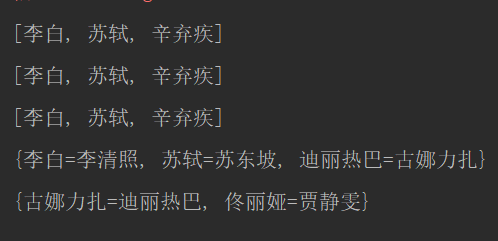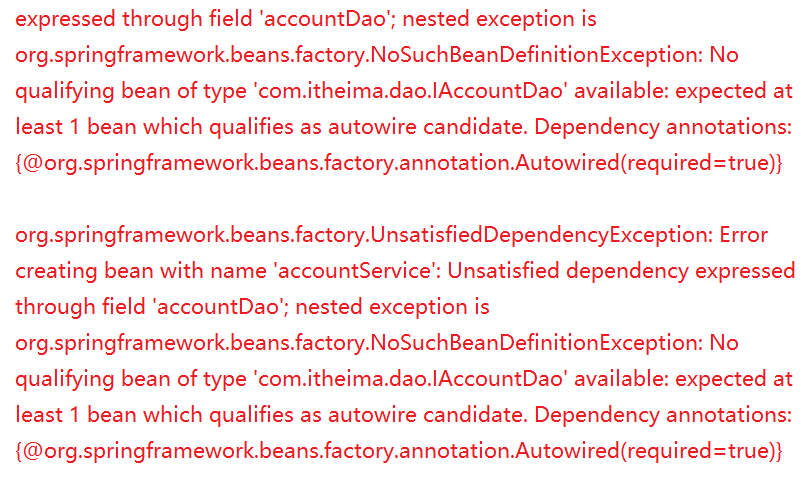spring中bean的细节之作用范围**
<!--<bean的作用范围
bean标签的scope属性:
作用;用于指定bean的作用范围
取值:
singleton:单例的(默认值)
prototype:多例的
request:作用于web应用的请求范围
session:作用于web应用的会话范围
global-session:作用于集群环境的会话范围(全局会话范围),当不是集群环境时,他是session
-->
<bean id="accountService" class="com.itheima.factory.StaticFactory" factory-method="getAccountService" scope="prototype"></bean>
bean对象的生命周期
单例对象:
出生:当容器创建是对象出生
活着:只要容器还在,对象一直活着
死亡:容器销毁,对象消亡
多例对象:
出生:当我们使用对象时spring框架为我们创建
活着:对象只要是在使用过程中就一直活着
死亡:当对象长时间不用,且没有别的对象引用是,由Java的垃圾回收器回收
spring的依赖注入
<!--spring中的依赖注入-->
<!--依赖注入:-->
<!--Dependenccy Injection-->
<!--IOC的作用:-->
<!--降低程序间的耦合(依赖关系)-->
<!--依赖关系的管理:-->
<!--以后都交给spring来维护-->
<!--在当前类需要用到其他类对象,由spring为我们提供,我们只需在配置文件中说明-->
<!--依赖关系的维护:-->
<!--就称为依赖注入-->
<!--依赖注入:-->
<!--能注入的数据:有三类-->
<!--基本类型和String-->
<!--其他bean类型(在配置文件或者注解配置过的bean)-->
<!--复杂类型/集合类型-->
<!--注入的方式:-->
<!--第一种:使用构造函数提供-->
<!--第二种:使用set方法提供-->
<!--第三种:使用注解提供-->
1.构造函数注入
首先定义可注入的变量
public class AccountServiceImpl implements IAccountService {
private String name;
private Integer age;
private Date birthday;
public AccountServiceImpl(String name,Integer age,Date birthday){
this.name = name;
this.age = age;
this.birthday = birthday;
}
public void saveAccount(){
System.out.println(name+":"+age+":"+birthday);
}
}
<!--构造函数注入
使用标签:constructor-arg
标签中的属性:
type:用于指定要注入的数据的数据类型,该数据类型也是构造函数中某个或某些参数的类型
index:用于指定要注入的数据给构造函数中指定索引位置的参数赋值,索引的位置从0开始
name:用于指定给构造函数中指定名称的参数赋值(常用)
=======================================
以上三个用于指定给构造函数的哪个参数赋值
=======================================
value:用于提供基本类型和String类型的数据
ref:用于指定其他的bean类型,他指的就是spring的Ioc核心容器中出现过的bean对象
-->
<bean id="accountService" class="com.itheima.service.impl.AccountServiceImpl">
<constructor-arg name="name" value="迪丽热巴"></constructor-arg>
<constructor-arg name="age" value="18"></constructor-arg>
<constructor-arg name="birthday" ref="now"></constructor-arg>
</bean>
<!--配置日期对象-->
<bean id="now" class="java.util.Date"></bean>

创建测试类调用对象方法,查看注入是否成功
public class Client {
public static void main(String[] args) {
//获取核心容器对象
ApplicationContext ac = new ClassPathXmlApplicationContext("bean.xml");
//2.根据id(唯一标识)获取Bean对象
IAccountService as = (IAccountService)ac.getBean("accountService");
System.out.println(as);
}
}

set方法注入:
1.给属性提供set,get方法
package com.itheima.service.impl;
import com.itheima.service.IAccountService;
import java.util.Date;
/**
* 账户的业务层实现类
*/
public class AccountServiceImpl2 implements IAccountService {
private String name;
private Integer age;
private Date birthday;
public String getName() {
return name;
}
public void setName(String name) {
this.name = name;
}
public Integer getAge() {
return age;
}
public void setAge(Integer age) {
this.age = age;
}
public Date getBirthday() {
return birthday;
}
public void setBirthday(Date birthday) {
this.birthday = birthday;
}
public void saveAccount(){
System.out.println(name+":"+age+":"+birthday);
}
}
2.XML配置
<bean id="now" class="java.util.Date"></bean>
<!--set方法注入
涉及的标签:property
标签的属性
name:用于指定注入时所调用的set方法名称
value:用于提供基本类型和String类型的数据
ref:用于指定其他的bean类型,他指的就是spring的Ioc核心容器中出现过的bean对象
-->
<bean id="accountService2" class="com.itheima.service.impl.AccountServiceImpl2">
<property name="name" value="迪丽热巴2"></property>
<property name="age" value="19"></property>
<property name="birthday" ref="now"></property>
</bean>
3.测试类
package com.itheima.ui;
import com.itheima.service.IAccountService;
import org.springframework.context.ApplicationContext;
import org.springframework.context.support.ClassPathXmlApplicationContext;
/**
* 模拟一个表现层,用于调用业务层
*/
public class Client {
public static void main(String[] args) {
//获取核心容器对象
ApplicationContext ac = new ClassPathXmlApplicationContext("bean.xml");
//2.根据id(唯一标识)获取Bean对象
IAccountService as = (IAccountService)ac.getBean("accountService2");
as.saveAccount();
}
}

注入结合数据
1.类中添加集合属性
package com.itheima.service.impl;
import com.itheima.service.IAccountService;
import java.util.*;
/**
* 账户的业务层实现类
*/
public class AccountServiceImpl3 implements IAccountService {
private String[] myStrs;
private List<String> myList;
private Set<String> mySet;
private Map<String,String> myMap;
private Properties myProps;
public String[] getMyStrs() {
return myStrs;
}
public void setMyStrs(String[] myStrs) {
this.myStrs = myStrs;
}
public List<String> getMyList() {
return myList;
}
public void setMyList(List<String> myList) {
this.myList = myList;
}
public Set<String> getMySet() {
return mySet;
}
public void setMySet(Set<String> mySet) {
this.mySet = mySet;
}
public Map<String, String> getMyMap() {
return myMap;
}
public void setMyMap(Map<String, String> myMap) {
this.myMap = myMap;
}
public Properties getMyProps() {
return myProps;
}
public void setMyProps(Properties myProps) {
this.myProps = myProps;
}
public void saveAccount() {
System.out.println(Arrays.toString(myStrs));
System.out.println(myList);
System.out.println(mySet);
System.out.println(myMap);
System.out.println(myProps);
}
}
3.配置xml
数组中的元素使用value标签提供
<!--复杂类型的注入/集合类型的注入
用于给List结构集合注入的标签
list array set
用于给Map结构集合注入的标签有
map props
结构相同,标签可以互换
-->
<bean id="accountService3" class="com.itheima.service.impl.AccountServiceImpl3">
<property name="myStrs">
<array>
<value>李白</value>
<value>苏轼</value>
<value>辛弃疾</value>
</array>
</property>
<property name="myList">
<list>
<value>李白</value>
<value>苏轼</value>
<value>辛弃疾</value>
</list>
</property>
<property name="mySet">
<set>
<value>李白</value>
<value>苏轼</value>
<value>辛弃疾</value>
</set>
</property>
<!--===============上面三个是单列集合=====================-->
<property name="myMap">
<map>
<entry key="李白" value="李清照"></entry>
<entry key="苏轼" value="苏东坡"></entry>
<entry key="迪丽热巴" value="古娜力扎"></entry>
</map>
</property>
<property name="myProps">
<props>
<prop key="古娜力扎">迪丽热巴</prop>
<prop key="佟丽娅">贾静雯</prop>
</props>
</property>
</bean>
4.测试数据是否注入集合
package com.itheima.ui;
import com.itheima.service.IAccountService;
import org.springframework.context.ApplicationContext;
import org.springframework.context.support.ClassPathXmlApplicationContext;
/**
* 模拟一个表现层,用于调用业务层
*/
public class Client {
public static void main(String[] args) {
//获取核心容器对象
ApplicationContext ac = new ClassPathXmlApplicationContext("bean.xml");
//2.根据id(唯一标识)获取Bean对象
IAccountService as = (IAccountService)ac.getBean("accountService3");
as.saveAccount();
}
}

使用注解创建对象
1.配置xml,告知spring注解存在的位置
<?xml version="1.0" encoding="UTF-8"?>
<beans xmlns="http://www.springframework.org/schema/beans"
xmlns:xsi="http://www.w3.org/2001/XMLSchema-instance"
xmlns:context="http://www.springframework.org/schema/context"
xsi:schemaLocation="http://www.springframework.org/schema/beans
http://www.springframework.org/schema/beans/spring-beans.xsd
http://www.springframework.org/schema/context
http://www.springframework.org/schema/context/spring-context.xsd">
<!--告知spring在创建容器是要扫描的包,配置所需要的标签在context名称空间和约束中-->
<context:component-scan base-package="com.itheima"></context:component-scan>
</beans>
2.加上注解:@Component
@Component
//作用:用于把当前类对象存入spring容器中
//属性 value:用于指定bean的id,当我们不写是,他的默认是当前类名,且首字母该小写
public class AccountServiceImpl implements IAccountService {
private IAccountDao accountDao = new AccountDaoImpl();
public AccountServiceImpl(){
System.out.println("对象创建了");
}
public void saveAccount(){ accountDao.saveAccount();
}
}
由Component衍生的注解
Controller:一般用于表现层
Service:一般用在业务层
Repository:一般用在持久层
以上三个注解他们的作用和属性与Component是一模一样的,他们三个是spring框架为我们提供明确三层使用的注解,使我们的三层对象更加清晰
自动按照类型注入
Autowired注解:作用:自动按照类型注入,只要容器中有唯一的一个bean对象类型和要注入的变量类型匹配,就可以注入成功
出现位置:可以是变量上,也可以是方法上
细节:在使用注解注入时,set方法就不是必须的
Qualifier注解:作用:在按照类中注入的基础之上再按照名称注入。它在给类成员注入时不能单独使用。但是在给方法参数注入时可以
属性value:用于指定注入bean的id。
Resource注解:作用:直接按照bean的id注入。它可以独立使用
属性name:用于指定bean的id。
以上三个注入都只能注入其他bean类型的数据,而基本类型和String类型无法使用上述注解实。另外,集合类型的注入只能通过XML来实现。
Value注解:作用用于注入基本类型和String类型的数据;
属性value:用于指定数据的值
Spring的新配置(取出xml的配置文件)
现在需要使用注解来去除 通过配置xml来获取的两个bean对象
<!--配置QueryRunner-->
<bean id="runner" class="org.apache.commons.dbutils.QueryRunner" scope="prototype">
<constructor-arg name="ds" ref="dataSource"></constructor-arg>
</bean>
<bean id="dataSource" class="com.mchange.v2.c3p0.ComboPooledDataSource">
<property name="driverClass" value="com.mysql.jdbc.Driver"></property>
<property name="jdbcUrl" value="jdbc:mysql:///eesy"></property>
<property name="user" value="root"></property>
<property name="password" value="12345"></property>
</bean>
实现方式
//Configuration 作用,指定当前类是一个配置类
//ComponentScan 作用,用于通过注解指定spring在创建容器是要扫描的包
//
@Configuration
@ComponentScan(basePackages = "com.itheima")//指定创建容器是要扫描的包
public class SpringConfiguration {
//用于创建一个QueryRunner对象
@Bean(name="runner")//用于把当前方法的返回值作为bean对象存入spring的IoC容器中
public QueryRunner createQueryRunner(DataSource dataSource){
return new QueryRunner(dataSource);
}
// 创建数据源对象
@Bean(name="dataSource")
public DataSource createDataSource(){
ComboPooledDataSource ds = new ComboPooledDataSource();
try {
ds.setDriverClass("com.mysql.jdbc.Driver");
} catch (PropertyVetoException e) {
e.printStackTrace();
}
ds.setJdbcUrl("jdbc:mysql:///eesy");
ds.setUser("root");
ds.setPassword("12345");
return ds;
}
}
在使用xml配置是获取容器是通过如下
ApplicationContext ac = new ClassPathXmlApplicationContext("bean.xml");
那么我们现在通过注解来获取容器就应该使用另外一个类来获取,如下
ApplicationContext ac = new AnnotationConfigApplicationContext(SpringConfiguration.class);
运行案例是报了错误:
NoSuchBeanDefinitionException: No qualifying bean of typeavailable: expected at least 1 bean which qualifies as autowire candidate. Dependency annotations:
具体错误信息如下

关键字:NoSuchBeanDefinitionException,说没有bean对象
原来是忘记在bean对象前加注解了dao层,和service层都要加
